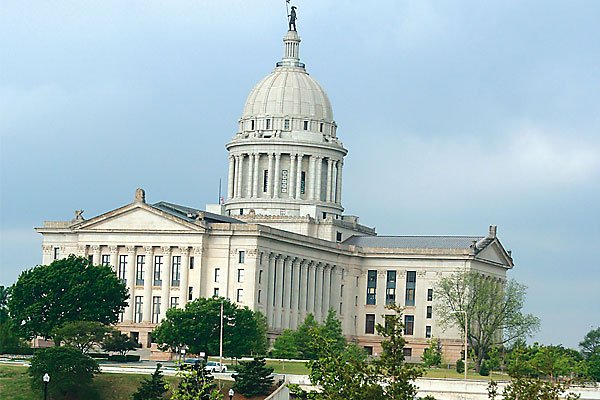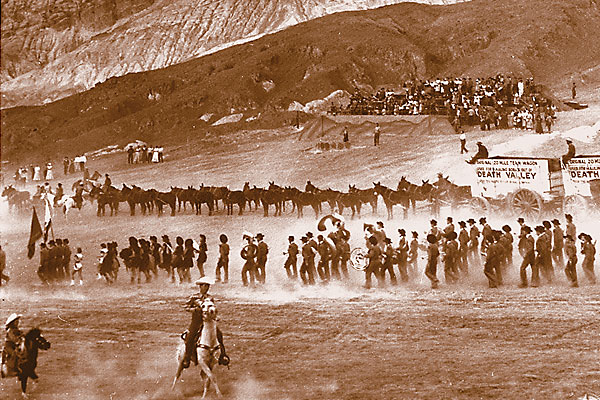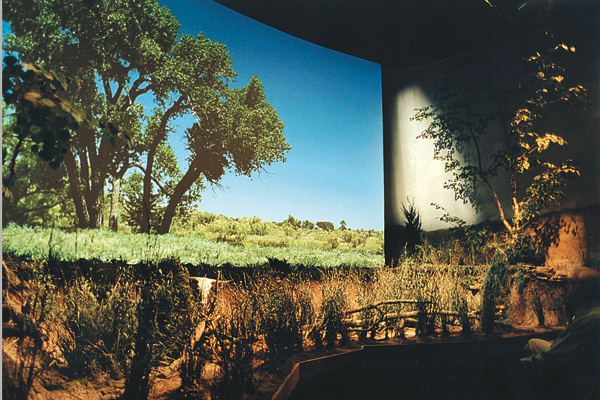 And they said it would never last.
And they said it would never last.
But here she is, Oklahoma, where the wind comes sweeping down the plains, hitting the century mark. Oklahoma, a state for 100 years.
The birthday party has been going on all year, but Oklahoma is worth visiting anytime. It’s a land of celebrities, from Bill Doolin to Pretty Boy Floyd, from Will Rogers to Wilma Mankiller, Boomers to Sooners, cowboys to Comanches. Let the celebration begin.
East of Eden
First thing to come to mind when I hear Sallisaw is John Steinbeck’s The Grapes of Wrath (see p. 39), but here I am at Sequoyah’s Cabin, paying respects to not a master of English but the creator of the Cherokee Syllabary at his 1829 cabin.
The Sallisaw area isn’t just Sequoyah and Steinbeck. It’s home to the 14 Flags Museum—meaning Oklahoma is more than two times better than all those Six Flags tourist traps—and the circa 1895 Overstreet-Kerr Historical Farm. The living-history farm offers tours as well as workshops (wanna learn how to make soap?).
From Steinbeck Country, head south to the scenic wonders of True Grit. Yeah, the movie was shot mostly in Colorado, but Charles Portis’ novel put Rooster Cogburn in the Winding Stair country. You can’t blame him. Southeastern Oklahoma is a naturalist’s dream.
My favorite spots are Beavers Bend State Resort and the Ouachita National Forest, but keep driving south to Idabel to check out the Museum of the Red River’s exhibits on various Indian cultures. Or you can donate your paycheck to the slot machines at Choctaw Casino.
Just down the road is Fort Towson Military Park. Established in 1824, Towson was an Army post until 1854. During the Civil War, Confederates made the fort its headquarters. Cherokee Stand Watie ended the war here in the summer of 1865, making him the last Confederate general to surrender.
Mountains and Muskogee
Most people don’t think of mountains when they hear Oklahoma, but north of Wilburton you’ll find the San Bois. Okay, the San Bois and the Winding Stairs aren’t the Alps, but you won’t find the Belle Starr View Lodge in Switzerland. Nor will you find Robbers Cave. Robbers don’t hide out these days at Robbers Cave State Park, but you will find plenty of people rappelling. And, farther up the road in Muskogee, you’ll find more than Merle Haggard.
Two must stops include the interpretive center at the historic site Fort Gibson, which saw active service from 1824-90, and the Five Civilized Tribes Museum, which preserves the heritage and legacy of the Cherokee, Creek, Chickasaw, Choctaw and Seminole, in the circa-1875 Union Indian Agency building. Twenty-nine buildings, and several more ruins, dot the landscape at the 80-acre
Fort Gibson.
If you have more time, drop in at the Ataloa Lodge Museum. If you love Indian art (especially Kachina dolls), make time. The 1932 lodge on the Bacone College campus features more than 20,000 pieces of Indian art, making it among the largest privately owned collections.
Cherokees, Will and Tom
No Oklahoma tour is complete without visiting the Cherokee capital of Tahlequah. Start off with a history
and cultural lesson at the Cherokee Heritage Center, including the Tsa La Gi Ancient Village replica of a 1600s Cherokee town.
Nor can you say you’ve really done Oklahoma if you haven’t done Will Rogers. With nine galleries and a 178-seat theater—and the humorist’s tomb—the Will Rogers Memorial in Claremore certainly pays homage to Rogers. As does the two-story log home just up the road in Oologah, where Rogers was born in 1879. The 400-acre property, now a living-history ranch, is home to longhorns, farm animals, a Will Rogers statue and a barn where you can watch films and newsreels of Rogers.
Rogers wasn’t Oklahoma’s only film star. The Tom Mix Museum in Dewey, where Mix lived in 1909, pays tribute to the silent Western movie star, bartender, lawman and 101 Ranch trick roper. The property includes a small theater, tons of photographs and Mix memorabilia. If you’re a real Tom Mix fan, make your way down to Beggs, south of Tulsa, and get yourself outfitted with a pair of custom cowboy boots at Blucher Boot Company. Mix often wore Blucher boots.
But don’t bypass Tulsa.
Take me back to Tulsa
Art lovers know few places can match Tulsa’s Gilcrease Museum’s collections of Indian and Western art and artifacts chronicling American history—you might be surprised to find a copy of the Declaration of Independence is housed here—from pre-European contact to our Westward exploration and settlement.
Yet there’s more art in Tulsa, in exhibits at the Philbrook Museum of Art (located in oilman Waite Phillips’ 1927 Tuscan-style estate) and in architecture along downtown’s walking tour of the Art Deco Landmarks. After all, in the late 1920s, folks called Tulsa the “Terra Cotta City.”
On the way to Oklahoma City, I figure it’s time to pay my respects, so I pull off I-44 and head into Chandler. Small museums sometimes hold wonderful treasures, and that’s certainly the case at the Lincoln County Museum of Pioneer History. The museum shows off Chandler’s heritage, from Route 66 to Bill Tilghman. The body of the legendary Oklahoma lawman, who was killed in the line of duty at age 70 as Cromwell’s city marshal, is buried in Chandler’s Oak Park Cemetery.
OK, let’s do OKC
Plan on spending a few days in Oklahoma City because it’ll take you an entire day to do the National Cowboy and Western Heritage Museum right. Something is always going on at the museum, and since we’re celebrating the state’s centennial, the photo exhibit, “Rushes to Statehood: The Oklahoma Land Runs,” runs through January 6.
The annual Red Earth Festival, celebrating Indian culture, traditions and art, in June is always worthwhile, and the city’s historic Stockyards district is worth a visit for shopping. For a more somber experience, the Oklahoma City Memorial movingly honors the victims—and survivors—of the 1995 bombing of the Alfred P. Murrah Federal Building.
Good times in Guthrie
One of Oklahoma’s most popular towns is Guthrie, with good reason.
Guthrie is the Land Run. The state’s first capital was born during the 1889 run, growing from a railroad stop to a city of more than 10,000 land seekers in one day. That heritage comes alive at museums such as the Oklahoma Territorial Museum, Oklahoma State Capital Publishing Museum and the Frontier Drugstore Museum, with its own collection of oddball museums (International Model Train and Automobile Museum, National Four-String Banjo Hall of Fame, Oklahoma Sports Museum). You can also catch a show at the Pollard Theatre or the Lazy E Arena, watch a Saturday afternoon gunfight (re-enactors, not gangsters) at the corners of Second and Harrison, or check out Guthrie’s pair of custom bootmakers, Ray Dorwart and Lisa Sorrell.
Trailin’ the Chisholm and Comanche
All this talk about bootmakers puts me in a cowboy mood, so it’s time to remember Oklahoma’s Chisholm Trail connection. That’s easy to do at the Chisholm Trail Museum in Kingfisher, and then follow the trail south to El Reno and historic Fort Reno, Duncan and the Chisholm Trail Heritage Center, and Waurika and the Chisholm Trail Museum.
Heading west now, one of Oklahoma’s most underappreciated stops is Lawton. The Fort Sill museum is an outstanding collection of military history. Not only that, lovers of boneyards can’t go wrong visiting the post’s cemeteries. Chief’s Knoll at the old post cemetery is a regular who’s who of Southern Plains Indian leaders, including Kicking Bird and Quanah Parker. Down the road in the Apache cemetery lies Geronimo’s body.
And, yes, there are mountains (sort of) in this part of the state too. Free-range buffalo, elk, deer and other wildlife call the 59,000 scenic acres of the Wichita Mountains Wildlife Refuge home, and I remember a Comanche Indian telling me how these mountains came to be.
“There were just plains out there,” he said. “Women and old people were camped there, with a couple of scouts left to watch the perimeter after the men left to go hunting. A scout came in and told them the Pawnee were coming, too many of them to fight, so the people began packing up camp, trying to get going. But an old medicine woman got some rocks in her hands, prayed and prayed and prayed. She told the others to go on, and they left her, and she planted those rocks and covered them up, then left. When she caught up with her people, they told her they had to hurry, but she said, no, and they turned around. There they were, the Wichita Mountains. She told them, ‘That will hold off the Pawnee ’til our warriors come back.’”
Makes sense to me.
Route 66 and Washita
Soon I’m back north, following old Route 66, stopping at the Oklahoma Route 66 Museum in Clinton and the National Route 66 Museum in Elk City. Elk City isn’t just Route 66, though. Next door is the Old Town Museum Complex, pleasantly recalling Elk City’s early heritage with replicas of an old town and its lifestyle.
Yet Oklahoma’s history hasn’t always been pleasant, and farther west, I am humbled and saddened in Cheyenne. The Black Kettle Museum and the Washita Battlefield National Historic Site both chronicle George Custer’s attack of the Cheyenne village in 1868.
Back on I-40, I’m heading west to Texas, leaving 100-year-old Oklahoma behind, only it’s not right to leave a birthday party on a depressing note such as the Washita.
But, dang me, if my eyes don’t deceive me, I’ll pass through Erick before hitting the Texas Panhandle. On the corner of Sheb Wooley Avenue and Roger Miller Boulevard (how cool is that!) stands the Roger Miller Museum. Miller always paid tribute to his boyhood home, and back in 2002, the citizens of Erick—along with Miller’s widow and son—decided to pay tribute to their favorite Country (and Broadway) musical icon.
Boy, do I feel like the King of the Road.





